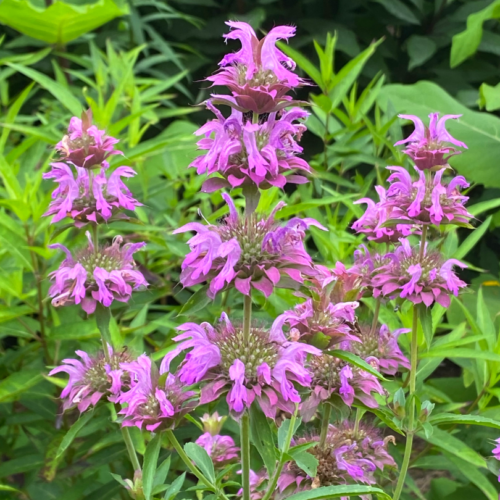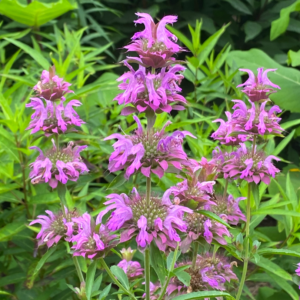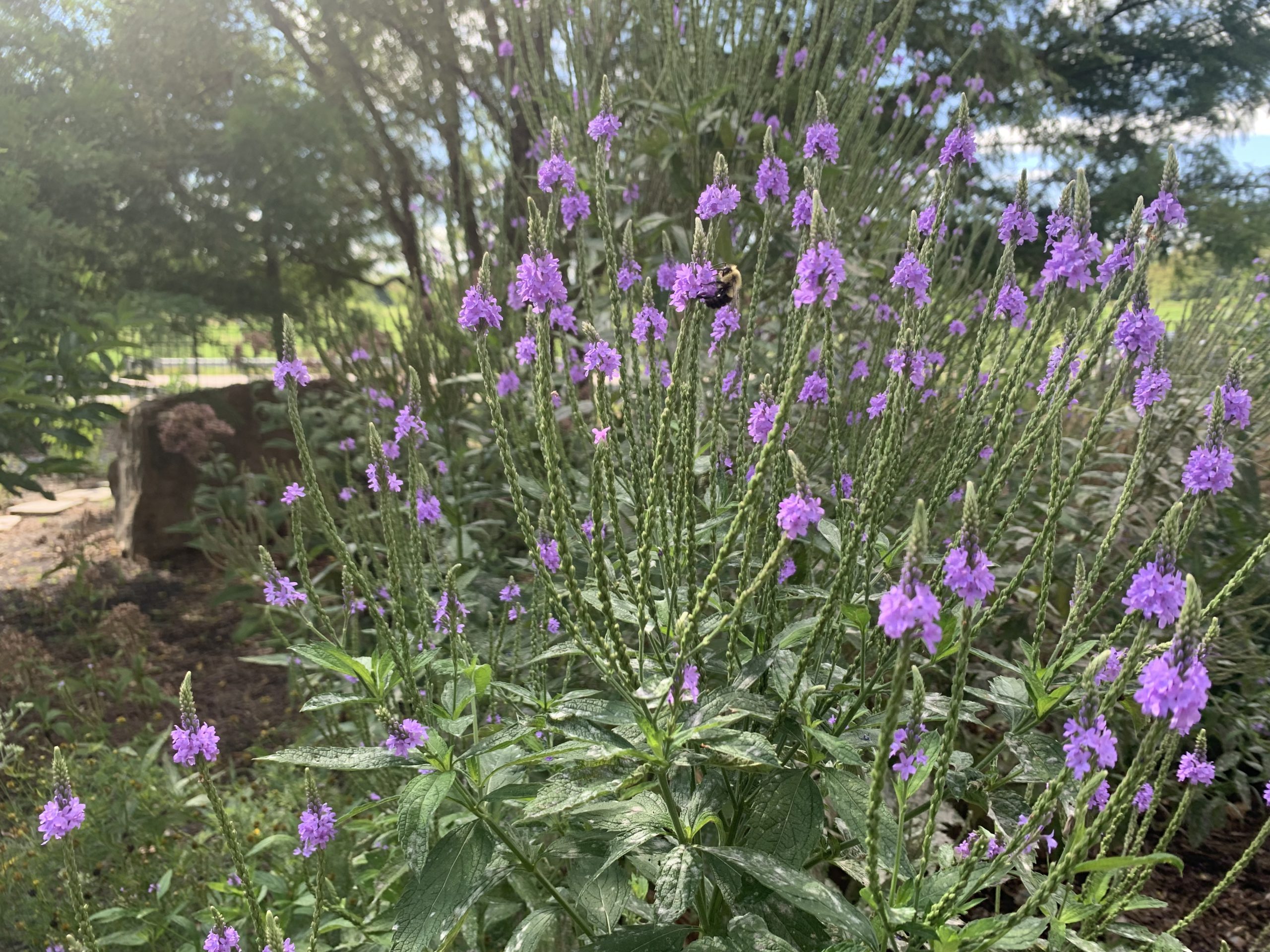
Welcome to the Discovery Garden!
The Discovery Garden features a wide variety of native trees, shrubs, grasses, vines, and flowering perennials. Many of these plants would have also been found here 5 million years ago during the Pliocene epoch when the fossil site was a watering hole that attracted the animals that are being uncovered today. The plants present in the garden were selected to attract pollinating insects and animals that play an important role in the food chain and the ecosystem.
The Discovery Garden also features seed-to-table interactive exhibits that showcase regional agricultural products that ultimately rely on these pollinators.
The Discovery Garden is open seasonally from mid-April through mid-October, with additional days when weather permits. The garden may be closed on certain days during open months due to weather, garden and path conditions, groups, or rentals.
Wildflowers
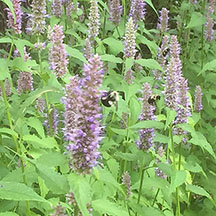
Anise Hyssop
Agastache foeniculum
Also known as blue/fragrant/lavender giant hyssop.
This premier pollinator plant attracts honey bees, butterflies, and hummingbirds. One acre can support 100 honeybee hives! It grows 2-3 feet tall and 3 feet wide from a small taproot with spreading rhizomes. It is part of the mint family.
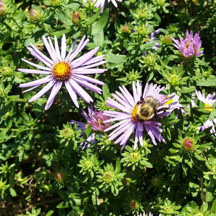
Aromatic Aster
Symphyotrichum oblongifolium
Also known as fall aster, wild blue aster, and shale aster.
Aromatic Aster attracts primarily bees and butterflies. It can grow 1-2 feet tall and up to 3 feet wide. Asters are some of the longest blooming group of flowers. The leaves release a strong balsam-like scent when crushed.
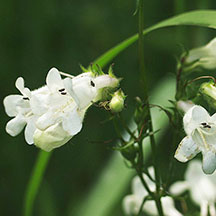
Beardtongue
Penstemon digitalis
Also known as foxglove beardtongue, but it is in a different genus from the foxglove.
Found in eastern Canada and the south eastern United States, the Beardtongue can grow 3-5 feet tall and 1-2 feet wide. Its white flowers attract bees, butterflies, and hummingbirds.
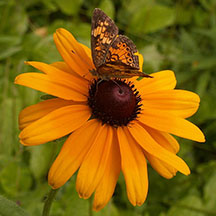
Black Eyed Susan
Rudbeckia fulgida var. fulgida
Also known as Gloriosa Daisy, Yellow Ox Eye, Sunflower, Coneflowers, Brown Eye Susan, Yellow Daisy, and Brown Betty.
There are more than two dozen wild species of Black-eyed Susans all with distinctive yellow petals. These perennials can grow up to 2 feet wide and 4 feet tall. The dark center can hold 250-500 individual flowers, and to pollinators, each one of these is a shallow nectar cup! They attract butterflies, bees, hummingbirds, flies, beetles, moths, wasps, sawflies, and goldfinches.
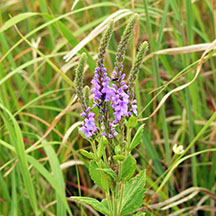
Blue Vervain
Verbena hastata
Also known as ironwork, wild hyssop, vervain, swamp vervain, blue verbena, swamp verbena, and simpler’s joy.
Blue Vervain can grow up to 6 feet tall and 1 to 2-1/5 feet wide. It primarily attracts bees and there is a species of bee (verbena bee) specialized to feeding on the pollen of verbenas.
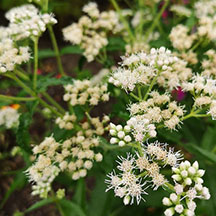
Boneset
Eupatorium perfoliatum
Also known as feverwort, agueweed, and sweating-plant.
Historically, this plant was introduced to American colonists by native persons who used the plant to “sweat off” fevers. This plant primarily attracts bees and butterflies and can grow 3 to 6 feet tall and 2 to 3 feet wide.
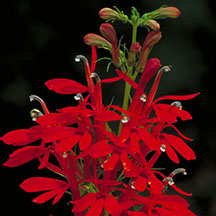
Cardinal Flower
Lobelia cardinalis
Also known as scarlet lobelia and bog sage.
The bright red color of the flowers and sweet nectar attract butterflies and many species of hummingbirds, primarily ruby-throated hummingbirds, and is ideal for use in hummingbird gardens.
It grows 2 to 4 feet tall and 1 to 2 feet wide.
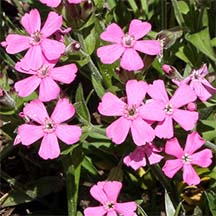
Carolina Pink
Also known as wild pink, Carolina Campion, or sticky catchfly.
This wildflower, which resembles phlox, stays low to the ground only growing about 1 foot tall and 1 foot wide. A single plant can produce 500-100 pink flowers!
It is sometimes called sticky catchfly because of the hairs on the calyx that are reminiscent of flypaper. This sticky, dry surface functions to deter ants from climbing the flower to steal the nectar.
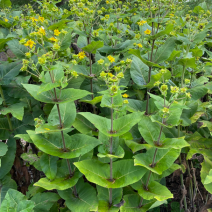
Cup Plant
Silphium perfoliatum
This hardy plant is known for its yellow blooms, coarse leaves, and super long stems. It gets its name from its leaves that form a small basin that enables water to pool around the square stem. It attracts butterflies, birds, bees, and other insects throughout the growing season of July-September. Pollinators are attracted to the large bright blooms, birds eat the seeds, and all take advantage of the water that can collect on the leaves. The Cup Flower is a perennial and can grow up to 10 feet tall and 4 feet wide.
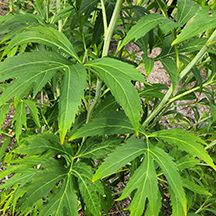
Cut Leaf Coneflower
Rudbeckia laciniata
Also known as Tall Coneflower, Green-headed Coneflower, Wild Goldenglow.
This perennial is found in almost every state across the U.S. It grows 3 to 10 feet tall and has bright yellow-daisy-like flowers that bloom July through October.
Its nectar attracts butterflies and American goldfinches eat the seeds in the fall.
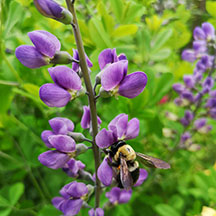
False Indigo
Baptisia australis
Also know as false lupine, indigo weed, blue wild indigo, blue false indigo, and rattle weed.
The false indigo primarily attracts butterflies and can grow 3 to 4 feet wide and 3 to 4 feet high.
Broken stems secrete a sap that turns dark blue on contact with the air and the plant has been used as a substitute for the superior dye-producing plant, Indigofera tinctoria.
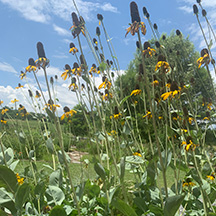
Giant Coneflower
Rudbeckia maxima
Also known as the great coneflower, giant brown-eyed susan, or cabbage coneflower.
The name cabbage coneflower is from the similarity of its basal leaves to cabbage.
Goldfinches will eat the seeds during the early fall.
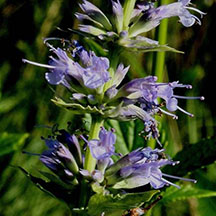
Giant Hyssop
Agastache scrophulariifolia
Also known as the purple giant hyssop.
The giant hyssop can grow up to 6 feet tall and primarily attracts butterflies and bees. Not all of the flowers on each stem bloom at once, meaning it will have blooms for a longer period of time.
Like many other members of the mint family, many people use this plant for its aromatic effects.
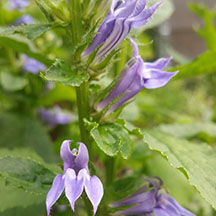
Great Blue Lobelia
Lobelia siphilitica
Also known as the blue cardinal flower and Virginia bellflower.
This colorful plant attracts butterflies, bees and occasionally hummingbirds. When a bee lands on the bottom petals, it triggers a release of pollen that is smeared on the bee’s back as it enters the flower for nectar.
It can grow 3 to 4 feet tall and 1 to 1-1/2 feet wide.
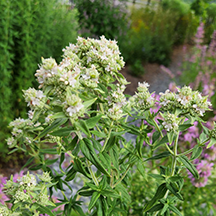
Hairy Mountain Mint
Pycnanthemum pilosum
Also known as American mountain mint.
This plant features small white flowers and grows 2-4 feet tall and 18-24 inches wide. It primarily attracts butterflies, insects, honey bees, wasps, and native bees.
It is often used in dried flower arrangements.
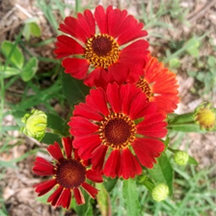
Helen’s Flower
Helenium autumnale
Also known as sneezeweed, swamp sunflower, yellow star, dog fennel, butterweed, and false sunflower.
This vibrant flower attracts bees, wasps, flies, and butterflies and can grow 3 to 5 feet tall and 2 to 3 feet wide. In late summer and fall one plant can produce as many as 100 flower heads in a branching array.
The genus name Helenium refers to the famous Helen of Troy. There is a legend that these flowers sprang from the ground where Helen’s tears fell.
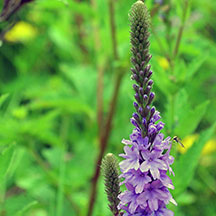
Hoary Vervain
Verbena stricta
Also known as hoary verbena, tall vervain, and woolly verbena.
This plant, which attracts bees, butterflies, and hummingbirds, is an extremely important component of many butterfly gardens, and it is one of the host plants for the larval form of the common buckeye butterfly. The seeds are also an important dietary portion of many small birds and mammals.
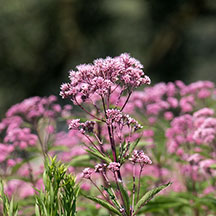
Joe Pye Weed
Eupatorium purpureum
Also known as grass root, gravel root, trumpet weed, and feverweed.
The plant can grow 5 to 7 feet tall and 2 to 4 feet wide. The flowers have a faint scent of vanilla and attract bees, butterflies, and hummingbirds. Seeds and flowers can be used to dye textiles shades of red or pink. Dried foliage and stems can be burned to repel mosquitoes and deer.

Lemon Bee Balm
Monarda citriodora
Also known as lemon mint and purple horsemint.
Lemon bee balm is an unusual plant because it sets many flowers on each stem, one above the other. Native to southern United States and northern Mexico, it tolerates full sun to partial shade.
The blooms primarily attract bees, butterflies, and hummingbirds. The plant dies with the first frost, and although an annual, its seeds can germinate and grow the following year.
The essential oil of lemon bee balm contains citronellol, which makes it useful as an insect repellent, including fleas and mites.
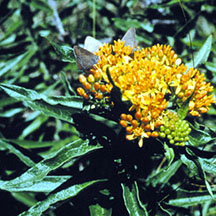
Orange Milkweed
Asclepias tuberosa
Also known as butterfly weed, Canada root, chigger flower, yellow milkweed, silky swallow-wort, and several others.
The orange milkweed can grow up to 2.5 feet tall and 2 feet across featuring long slender leaves and clusters or orange or yellow flowers. It primarily attracts bees and wasps but also attracts butterflies and is the larval host of several butterflies and moths, including the monarch butterfly. In fact, monarch butterflies will only lay their eggs on milkweed plants.
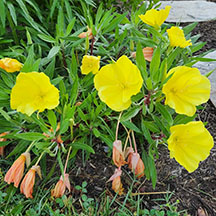
Ozark Sundrop
Oenothera macrocarpa
Also known as yellow evening primrose, Mexican primrose, and Missouri primrose.
This plant blooms yellow flowers in early summer and grows up to 8″ tall and 16″ wide. The flowers open intthe evening for night flying moths, which linger around the flowers very early in the morning. It also attracts butterflies.
The seed pods are often used in flower arrangements.
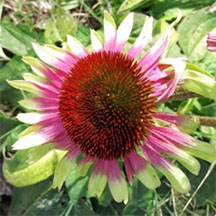
Pale Purple Coneflower
Echinacea pallida
Also known as eastern purple coneflower, hedgehog coneflower, and echinacea.
This plant, which is part of the Aster family, can grow up to 4 feet tall and 3 feet across. A flower grows at the top of each stem and attracts butterflies, bees, and other pollinators. The flower heads produce seeds which are readily consumed by birds such as goldfinches.
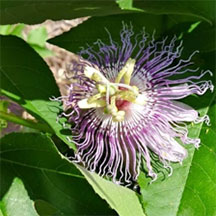
Passionflower
Passiflora incarnata
Also known as purple passionflower, wild passion vine, maypop, true passionflower, and wild apricot.
This trailing vine has white flowers with a purple fringe, and is visited by pollinators such as bumblebees and carpenter bees. It is also a larval host for several butterflies and its fruit may be eaten by songbirds and some mammals.
The passionflower is one of three Tennessee state flowers: irises are the state cultivated flower, while the passionflower and the Tennessee coneflower are both state wildflowers.
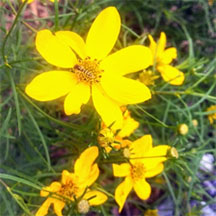
Perennial Sunflowers
Helianthus angustifolius
Also known as swamp sunflowers, narrow-leaf sunflowers, and mountain daisy. It can grow to a height of 10 feet but are typically five to seven feet tall.
Sunflowers are pollinator superheroes since they are tall and brightly colored and their broad, flat faces make it easy for butterflies and other insects to land on them. They primarily attract honey bees, bumblebees, butterflies, moths, and beetles. Birds are also attracted to the seeds. The species found in the Discovery Garden do not produce the type seeds that are edible for humans. While they are growing, they will tilt during the day to face the sun but stop once they begin blooming.
In autumn, lovely bunches of golden yellow flowers attract drifts of migrating butterflies, songbirds, and other pollinators. This late-blooming sunflower extends the season of yellow flowers in the garden until the first frost.
Sunflowers are drought tolerant, low maintenance, and deer resistant. They occur in the eastern United States from New York to Florida and as far west as Oklahoma and Texas.
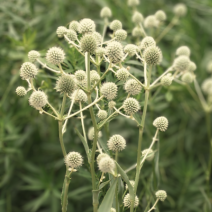
Rattlesnake Master
Eryngium yuccifolium
Also known as button snake-root, button eryngo, beargrass, yucca-leaf eryngo, rattlesnake flag, and rattlesnake weed.
This plant primarily attracts wasps but also attracts many other insects including short and long-tongued bees, flies, beetles, ad butterflies. It is the larval host to the rattlesnake-master borer moth. It can grow up to 5 feet tall and features stiff, long, narrow leaves with a sharp tip and flowers that are ball-shaped umbels at the top of each stem.
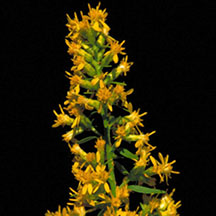
Showy Goldenrod
Solidago speciosa
Also known as the showy goldenrod.
This plant can from 3 feet tall and 2 to 3 feet wide. Goldenrods have been wrongly accused of causing hay fever which is actually an allergic reaction to wind-borne pollen from other plants such as ragweed.
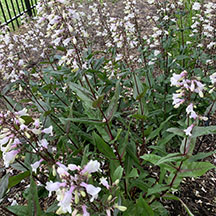
Small’s Beardtongue
Penstemon smallii
Also known as beardtongue and foxglove beardtongue.
Blooming in June and July, this beautiful perennial features cute bell-shaped flowers that attract butterflies, honey bees, native bees, and hummingbirds. It groms 18-30 inches tall and 18-24 inches wide.
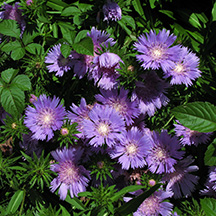
Stokes Aster
Stokesia laevis
Also known as cornflower aster.
This plant blooms a bright purple flower, 3-4 inches large, in mid-summer to early fall attracting butterflies, bumblebees, and hummingbirds.
It grows 1-2 feet tall and 1.5 feet wide. Blooms often close in the evening and reopen in the morning.
They are native to the southeastern United States, and occur naturally in wetlands, bottomlands, wet pinewoods, savannas and ditches. They are drought tolerant, low maintenance and are evergreen in warm winter climates. They have no serious pest or disease issues and are rabbit resistant.
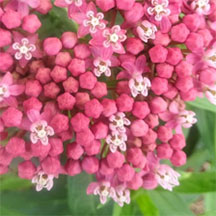
Swamp Milkweed
Asclepias incarnata
Also known as rose milkweed, rose milk flower, swamp silkweed, and white Indian hemp.
This plant can grow to 5 feet tall and features small fragrant pink or sometimes white flowers attract many species of insects, including the monarch butterfly. The queen butterfly also lays its eggs on milkweed plants, and they are commonly mistaken for monarch caterpillars.
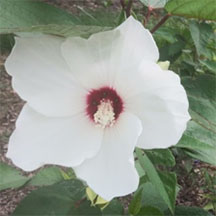
Swamp Rose Mallow
Hibiscus moscheutos
Also known as rose mallow, crimson eyed rose mallow, eastern rosemallow, and marshmallow hibiscus.
This plant, which can grow up to 7 feet tall has large, heart-shaped leaves and flowers that have 5 pink-white petals with a red-purple center. It attracts hummingbirds and butterflies and is the caterpillar host plant for 25 species of butterflies and moths.
The rose-mallow bee is a specialist pollinator of native Hibiscus species including the swamp rose mallow.
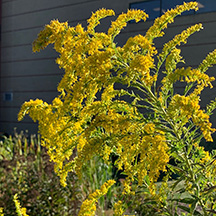
Sweet Goldenrod
Solidago odora
Also known as Anise Goldenrod, Fragrant Goldenrod, and Licorice Goldenrod.
This perennial grows 2-4 feet tall and blooms yellow in late summer to autumn and the leaves have an anise or licorice scent when crushed.
Goldenrods are among the most important source of fall nectar and pollen for native bees, honey bees, and butterflies. Much of the fall honey in the U.S. comes from goldenrod nectar.
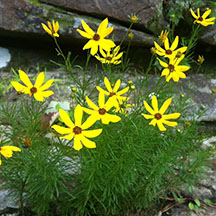
Threadleaf Coreopsis
Also known as tickseed, calliopsis, and goldenwave.
This member of the aster family can grow 2-4 feet tall, and 1-2 feet wide. It primarily attracts bees and butterflies as well as insects and birds.
Multiple varieties of the coreopsis are available in a variety of colors including purples and lavenders, oranges, pinks and deep reds.
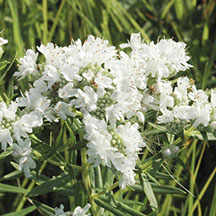
Threadleaf Mountain Mint
Pycnanthemum tenuifolium
Also known as threadleaf mountain mint, Virginia thyme and common horse mint.
Bees, butterflies, wasps, beetles, skippers, and flies are all attracted to these white blooms. The plant grows 2 to 4 feet tall and 2 to 3 feet wide. Despite being called “mountain mint’ it is able to grow in a variety of habitats.
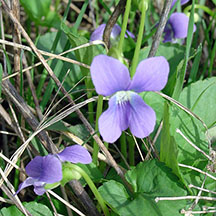
Violet
Viola sororia
Also known as the common blue violet, common meadow violet, purple violet, wooly blue violet, hooded violet, and wood violet.
This small plant only grows up to 4 inches tall and 6 inches across. It features five unequal petals that attract butterflies and bees. Butterflies and moths use this plant as a larval host and ants and small mammals utilize the seeds as a food source.
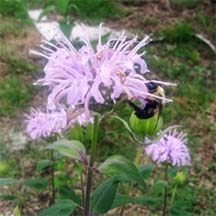
Wild Bergamot
Monarda fistulosa
Also known as bee balm, wild bee balm, horse-mint, and eastern bergamot.
The wild bergamot is a member of the mint family and can grow up to 4 feet tall and 3 feet wide. Its lavender-colored blossoms are a cluster of 20 to 50 flowers and primarily attract butterflies, bees, hummingbirds, and moths. It is the larval host to the hermit sphinx moth, the orange mint moth, and the raspberry pyrausta butterfly.
Shrubs
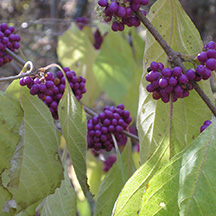
American Beautyberry
Callicarpa americana
Also known as beautyberry, French mulberry, sour bush, and American mulberry.
This shrub usually grows 3-5 feet tall, although it can reach up to 9 feet tall, and 3-5 feet wide.
The seeds and berries are important foods for many species of birds, particularly the Northern Bobwhite. It also attracts birds and butterflies. It also attracts mammals such as opossum, raccoons, fox, squirrels, and white-tailed deer.
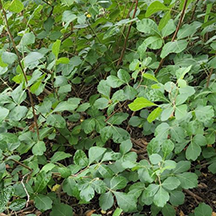
Aromatic Sumac
Rhus aromatica
Also known as fragrant sumac, lemon sumac, polecat bush, sweer-scented sumac, three-leaf sumac, and skunk-bush sumac.
This shrub is very beneficial to a variety of animals. The nectar attracts adult butterflies and birds. Its berries provide food for small animals and birds including Townsend’s Solitaires, wild turkey, ruffled grouse, and flickers as well as mammals such as raccoons, opossum, and deer. It provides a special value to native bees and honey bees providing nesting materials.
It can be thicket-formins with arching branches and has trifoliate leaves resembling a miniature version of poison ivy, which is in the same family, but rarely causes itching.
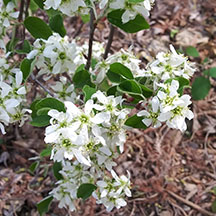
Black Chokeberry
Aronia melanocarpa
This small to medium sized shrub can range from 3 to 5 feet. Small clusters of white flowers in the spring are followed by glossy black fruit. Its dark green foliage turns reddish-purple in the fall.
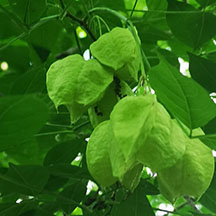
Bladdernut
Staphylea trifolia
Also known as American bladdernut.
This large shrub (or small tree) can grow 8 to 15 feet tall. It features drooping clusters of white or cream, bell-shaped flowers and fruit which changes from green to yellow to brown. The flowers turn into papery seed pods that can persist through the winter.
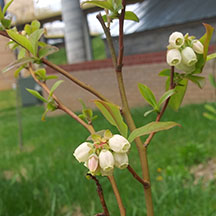
Blueberry
Cyanococcus vaccinium
This perennial flowering plant features blue or purple berries. The flowers are bell-shaped, white, pale pink or red, and sometimes tinged greenish. It can grow up to 13 feet tall.
Blueberry plants reproduce by cross pollination, with each seed producing a plant with a different genetic composition. The mother plant develops underground stems called rhizomes, creating a large patch that is genetically identical to the mother plant.
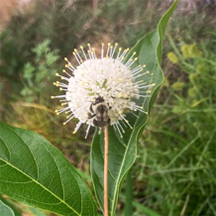
Buttonbush
Cephalanthus occidentalis
Also known as common buttonbush, button willow, and honey-bells.
This deciduous, perennial shrub attracts many pollinators including bees, butterflies, and birds. It also serves as a food source for the larval stage of some moths.
It can grow 6 to 12 feet and in the summer months it features 1 inch balls of white flowers resembling pin cushions and button-like balls of fruit. The trunks and branches are often twisted, crooked, and leaning.
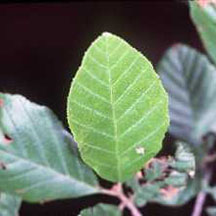
Hazel Alder
Alnus serrulata
Also known as tag alder and smooth alder.
The hazel alder is a multi-stemmed, suckering, thicket-forming, large deciduous shrub or small tree that typically grows to 10′-20′ tall. It is primarily found in swampy or wet areas. It features both male and female flowers on the same tree with the male being brownish-yellow and the female being bright red.
It primarily attracts butterflies, specifically harvester butterflies. The caterpillars of this butterfly feed on the aphids found on the plant. These caterpillars are the only carnivorous caterpillars in the US. Birds feed on the seed.
*2
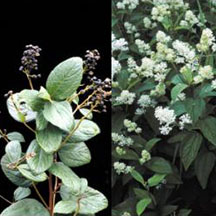
New Jersey Tea
Ceanothus americanus
Also known as redroot, mountain sweet, and wild snowball.
This shrub normally grows to only 3 feet tall. It has small white flowers that grow in oval clusters.
Turkeys and quail eat the seeds and the flowers attract butterflies and birds.
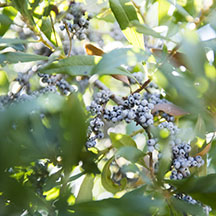
Northern Bayberry
Myrica pensylvanica
The northern bayberry is a deciduous shrub that can grow 5 to 10 feet tall. The male plants can have yellowish green blooms in May. Its fragrant leaves and fruits attract various birds, although it need at least one male plant to facilitate pollination of the female plants.
The fruits are covered with an aromatic, waxy substance which is used to make bayberry candles, soaps, and sealing wax.
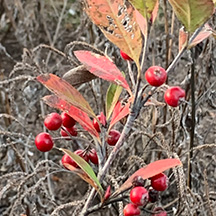
Red Chokeberry
Aronia arbutifolia
This deciduous shrub blooms in the spring and attracts both butterflies and bees while its fruit attracts songbirds.
It grows 6-10 feet tall and 3-6 feet wide.
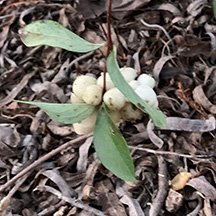
Snowberry
Symphoricarpos albus
Also known as common snowberry.
This deciduous shrub produces white berries that attract hummingbirds, butterflies, and birds.
It blooms in the summer and grows 3-6 feet tall and 3-6 feet wide.
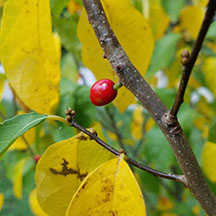
Spicebush
Lindera benzoin
Also known as spice wood and Benjamin bush.
This deciduous shrub is a fast grower and can reach 6 to 12 feet tall. Dense clusters of tiny, pale yellow flowers bloom and are followed by glossy red fruit. Both the fruit and the foliage are aromatic. The leaves turn a colorful golden-yellow in the fall.
It attracts butterflies and moths including the spicebush swallowtail, promethea silk moth, and easter tiger swallowtail.
These plants are dioecious, meaning male and female flowers are found on separate plants.
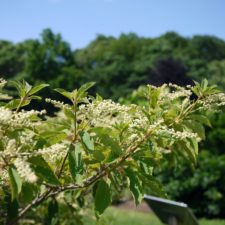
Summersweet
Clethra alnifolia
Also known as summersweet, clethra, coastal sweet pepper bush, and sweet pepperbush.
It can grow 8 feet tall and 6 feet wide and has lustrous green leaves in the spring, spiky white or pink fragrant flowers during the summer, golden yellow leaves in the fall, and delicate dried seed capsules in the winter.
It is a source if nectar for hummingbirds and a variety of butterflies. Songbirds will eat its seeds.
*3
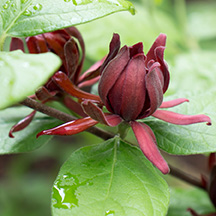
Sweet Shrub
Calycanthus floridus
Also known as carolina-allspice, strawberry-shrub, bubby blossom, sweet hubby, sweet betty, and spice bush.
This tree grows 6-9 feet tall. Its reddish-maroon blooms grow in May-July to 2 inches and have a very fruity fragrance. They attract butterflies, beetles, and other insects.
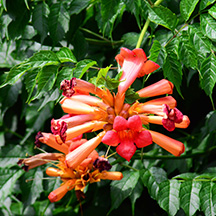
Trumpet Honeysuckle
Lonicera sempervirens
Also known as trumpet vine, coral honeysuckle, honeysuckle, woodbine, and scarlet honeysuckle.
It produces clusters of bright red flowers in the spring that attract birds, butterflies, and hummingbirds and hosts larvae of the spring azure butterfly and snowberry clearwing moth. It is also valuable to bumblebees.
This vine is vigorous but not aggressive like some species of honeysuckle and can grow 10-20 feet high.
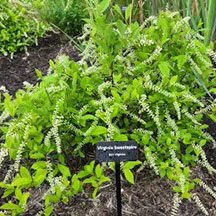
Virginia Sweetspire
Itea virginica
Also known as Virginia willow and tassel white.
This deciduous to semi-evergreen shrub blooms in early summer and its flowers attract butterflies and bees while its seeds attract songbirds.
It can grow 4-8 feet tall and 3-6 feet wide.
It is considered deer-resistant.
Grasses
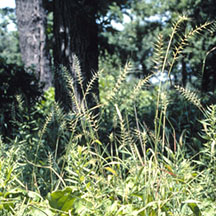
Bottlebrush Grass
Hystrix patula and Elymus hustrix
Bottlebrush grass is a perennial grass that is native to most of the eastern U.S. and Canada. It produces white flowers that bloom in the spring. The grass is green but turns brown beginning in late summer. It prefers full or partial sun exposure and the seed heads can grow up to five feet tall, much taller than the leaves of the grass which only grow to about one foot tall.
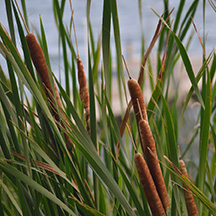
Cattails
Typha latifolia
Also known as bulrush, reedmace, and corndog grass.
This useful plant is spread primarily by the wind and through creeping roots called rhizomes.
It can be very beneficial to many species, including humans. In the wild, it also provides a safe haven for tiny fish and creates shelter for mammals and birds. Birds also use the fluff from the seeds as nesting material.
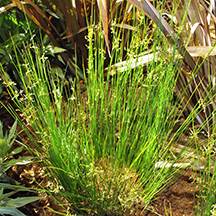
Common Rush
Juncus effusus
Also known as green bull rush, Japanese mat rush, and soft rush.
This plant, which can grow to 4 feet high, primarily attracts birds, butterflies, and moths. Muskrats feed on the root stalks and birds find shelter among the stems.
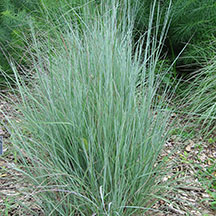
Little Bluestem
Schizachyrium scoparium
Also known as beard grass.
This bluish-green grass can grow 2 to 4 feet tall and 1-1/2 to 2 feet wide. The roots can extend up to 8 feet underground. Flowering stalks which grow in July can reach 4 to 5 feet in height.
This species is commonly grown for use in hay production.
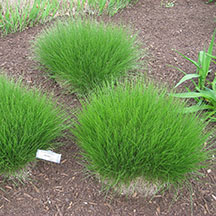
Prairie Dropseed
Sporobolus heterolepis
Prairie dropseed is a perennial bunchgrass that that typically grows 1 to 2 feet tall and 2 to 3 feet across. Its flowering stems can grow up to 3 feet tall, extending above the leaves. It can range in color from a rich green in summer to a golden rust color in the fall.
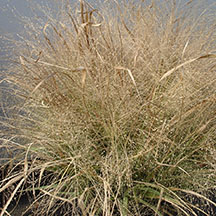
Purple Love Grass
Eragrostis spectabilis
This native bunchgrass forms a neat, tight clump. It is often green in the spring and summer. It becomes covered with a cloud of fine purple plumage containing tightly packed seeds. The plumage can add up to 6 inches to the height of the plant. The leaves turn purple and the flowers fade to white in the fall. The plumage eventually breaks away from the plant and rolls around like tumbleweed.
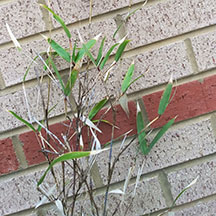
River Cane
Arundinaria gigantea
River cane is a species of bamboo known as giant cane. It is a perennial grass with a rounded, hollow stem which can exceed 2.8 inches in diameter and grow to a height of 33 feet.
This cane is the food plant for the southern pearly eye butterfly and is an important habitat and nesting site for several species of warbler.
River cane can be used in basketry, flutes, candles, walls for dwellings, fish traps, and sleeping mats.

Sedges
Cyperus esculentus
This plant can grow up to 3 feet tall. While they do technically have “flowers”, sedge flowers are nondescript and don’t rely on pollinators to reproduce. Even though they are often considered weeds, sedges play an important role in pollinator gardens in less obvious ways than other plants. They provide food, shelter, and support for the birds and mammals that regulate the insect populations.
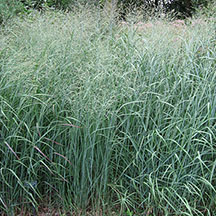
Switchgrass
Panicum virgatum
Also known as tall panic grass, Wobsqua grass, blackbelt, tall prairie grass, wild redtop thatch grass, and Virginia switchgrass.
Switchgrass is commonly used for soil conservation, forage production, ornamental grass, in phytoremediation projects, fiber, electricity, heat production, for biosequestration of atmospheric carbon dioxide, and more recently as a biomass crop for ethanol and butanol.
Trees
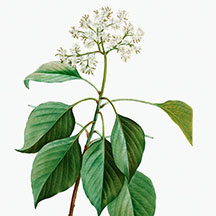
Alternate Leaf Dogwood
Cornus alternifolia
Also known as pagoda dogwood, blue dogwood, and green osier.
This tree can grow up to 25 feet tall with leaves up to 5 inches long which turn a reddish purple in the autumn. Its flat topped crown and horizontal layers of branches led to the nickname “pagoda dogwood.”
Its purplish-blue berry-like fruits provide suspense for an abundance of wildlife and its primary pollinators are butterflies, bees, and moths.
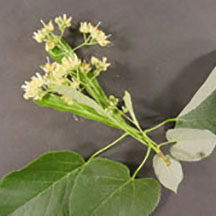
American Basswood
Tilia americana
Also known as Honey Tree, Bee Tree, and Linden.
This is a fast growing, moderately shade tolerant, oval shaped tree with dense foliage that reaches a height of 75 to 130 ft, living up to 200 years. Its leaves are heart shaped and range from 3-6 inches across. The flowers are small but bees love the sweet, abundant nectar which produces a distinctive honey, thus the name “Bee Tree.” New trees sprout easily from he stumps of cut trees.
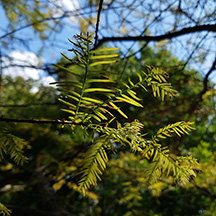
Bald Cypress Tree
Taxodium distichum
Also known as swamp cypress.
The bald cypress tree can grow 24 to 36 inches per year, up to 80 feet tall and 30 wide when mature. It is very hardy and adapts to a wide range of soil types – wet salty, dry, or swampy. It is noted for the russet-red fall color of its lacy needles. The oldest known Bald Cypress Tree is in North Carolina and is over 600 years old!
In addition to squirrels, many birds eat the seeds including wood ducks, wild turkey, evening grosbeak, waterfowl, and wading birds. Older trees form natural hollows that can be used as cover by wildlife and provide cover and breeding sites for frogs, toads, salamanders, and catfish.
* This tree is not native to this area and existed on-site prior to the installation of the Discovery Garden.
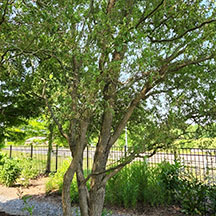
Curly Willow
Salix matsudana
Also known as the pekin willow.
The curly willow can grow up to 35 feet tall and have a 20 foot spread. One of its most unusual features are its wavy branches, giving gardens some winter interest.
* This tree is not native to the U.S. and existed on-site prior to the installation of the Discovery Garden.
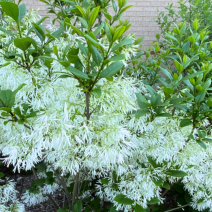
Fringe Tree
Chionanthus virginicus
Also known as White Fringe Tree, American Fringe Tree, Poison Ash, Old Man’s Beard, Grancy Greybeard
The fringe tree belongs to the Olive family and is a small multi-stemmed tree or shrub growing 25-30 feet tall with oblong leaves 3-8 inches long. It also features clusters of fragrant white flowers with four fringe-like petals in the spring. Birds and small animals love the deep blue olive shaped fruits that develop in late summer.
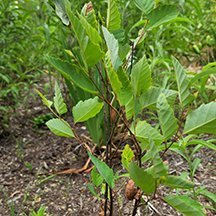
River Birch
Betula nigra
Also known as black birch and water birch.
At maturity, the river birch can grow 40-70 feet tall with a spread of 40-60 feet.
Many birds including chickadees, songbirds, wild turkey, pine siskins, and finches, eat the seeds. The foliage is eaten by deer and others.
It is often used for furniture manufacturing, basket materials, small woodenware, and fuel.
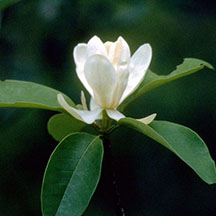
Sweet Bay Magnolia
Magnolia virginiana
Also known as southern sweet bay, swamp bay, swamp magnolia, laurel magnolia, beaver tree, and others.
The multi-stemmed tree can grow to 20 to 60 feet tall and features darkish green leaves and creamy white flowers. It primarily attracts beetles, moths, and butterflies, including the eastern tiger and zebra swallowtail butterflies. In late summer their red fruit attracts blue jays and other songbirds, squirrels, small rodents, turkey, and quail.
It is popular for its fragrant flowers that remain on the tree over a long time. The twigs and foliage have a spicy aroma.
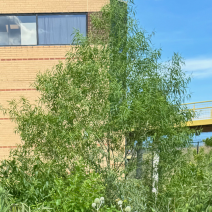
Willow
Salix babylonica
Also known as sallows, osiers, and weeping willow.
Willows are fast-growing trees, growing up to 82 feet tall but only lives 40-75 years.
They provide food for rabbits, beavers, and big game such as deer. It also provides nesting sites for numerous small birds and mammals. It also attracts adult butterflies, larvae, and many specialized bees.
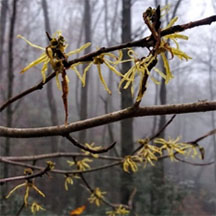
Witch Hazel
Hamamelis virginiana
Also known as winterbloom, southern witch hazel, and common witch hazel.
Witch hazel is a shrub or small tree that can grow 20 to 30 feet tall with spreading branches. Its flowers are about 1 inch wide with bright yellow thread-like, twisted petals that emerge between October and December. Its primarily pollinators are moths.
Discovery Garden Sponsors
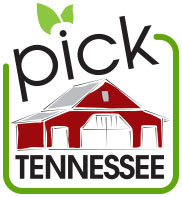
This outdoor exhibit space was funded in part by the sale of Agricultural Speciality License Plates (the “Ag Tag”). Additional information about Tennessee agricultural products and the “Ag Tag” is available at the Tennessee Department of Agriculture’s promotional Web site, picktnproducts.org.
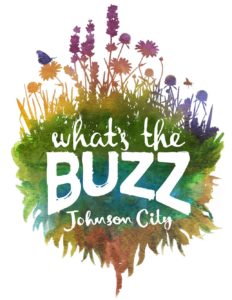
Sponsored by What’s the Buzz, a local non-profit promoting the creation and expansion of pollinator habitats.
This garden is tended by the Northeast Tennessee Master Gardeners (NETMGA) www.netmga.net and area volunteers.
Image Credits
2 – Robert H. Mohlenbrock, hosted by the USDA-NRCS PLANTS Database / USDA SCS. 1989. Midwest wetland flora: Field office illustrated guide to plant species. Midwest National Technical Center, Lincoln.
3 – “Summersweet” by madprime is licensed under CC BY-SA 2.0
•• While a variety of these plants may have been used in antiquity (or may still be used) for herbal or medicinal purposes, the descriptions on this page are for informational purposes only. You are responsible for your own wellness and should consult a health care provider if you have any questions about your health. ••





